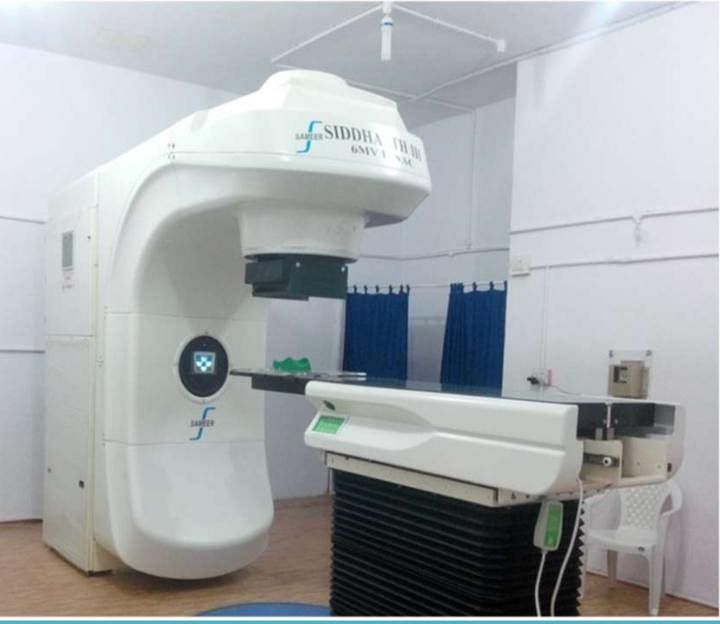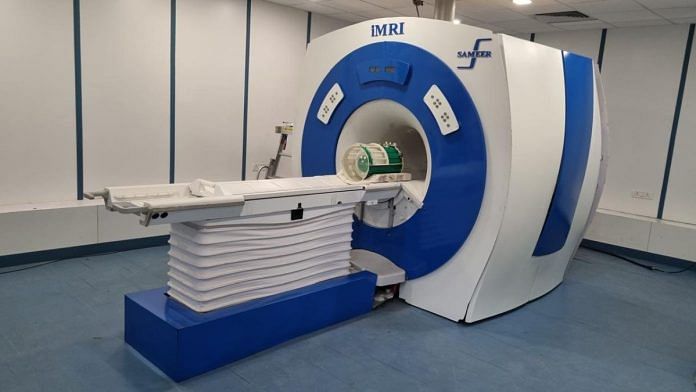New Delhi: India’s first domestically developed magnetic resonance imaging (MRI) machine, which promises to bring down the cost of this critical medical equipment by up to 40–50 percent, is expected to be installed at the All India Institute of Medical Sciences (AIIMS)-Delhi this October, making MRI scans more affordable for patients.
The machine, following clinical trials at AIIMS-Delhi, is also expected to be used in smaller hospitals across the country, bringing relief to lakhs of patients who pay through the nose for such scans, used for detecting a number of health conditions including tumours.
Besides making scans cheaper, the indigenously developed MRI machine is also expected to, in some measure, bring down India’s reliance on imported medical devices. Though indigenously developed, the machine still relies on a few imported components, as Indian industries currently lacks the capability to manufacture them.
An MRI machine is a medical device that uses powerful magnetic fields and radio waves to produce detailed images of the body’s internal parts. It is especially effective in visualising soft tissues such as organs, muscles, and the brain, offering clearer insights than X-rays or CT scans for certain health conditions.
AIIMS-Delhi signed a Memorandum of Understanding (MoU) with the Society for Applied Microwave Electronics Engineering and Research (SAMEER), an autonomous research and development (R&D) organisation under the Ministry of Electronics and Information Technology earlier this week.
Based in Mumbai, SAMEER specialises in research, development, and commercialisation of microwave electronics, electromagnetic technology, and related fields. AIIMS will also partner with SAMEER on various other projects related to medical hardware diagnostics.
Professor Rama Jayasundar, head of the Department of Nuclear Magnetic Resonance (NMR) at AIIMS-Delhi, highlighted the cost benefits of an indigenously developed MRI machine. “It could reduce expenses for MRI by 40–50 percent as told by the director general of SAMEER, MeitY, ultimately making scans more affordable for patients,” she told ThePrint.
She added that smaller hospitals, which might otherwise struggle to afford such equipment, would now be in a position to purchase these machines. “This will significantly improve affordability and accessibility for smaller healthcare facilities,” she said.
In private hospitals, MRI scans typically cost between Rs 8,000 and Rs 12,000 per organ, meaning a scan of two organs could cost Rs 16,000 or more, depending on the facility.
In contrast, government hospitals charge Rs 3,000 for a routine MRI, with an additional Rs 1,500 for each extra organ.
For patients holding a Below Poverty Line (BPL) card or those from economically weaker backgrounds, the scans are provided free of cost. With the introduction of this new machine, costs are expected to decrease even further.
The machine is set to be installed in October this year for clinical trials at AIIMS but before that, Dr Hanumantha Rao, director general of SAMEER, explained that there will be an initial phase, which will focus on ensuring the equipment meets technical requirements.
“We will first conduct preliminary trials to ensure it functions as expected,” he told ThePrint. He emphasised that, as engineers and scientists, their role is to assess the equipment’s performance, image quality, and overall functionality. But he acknowledged that the clinical interpretation of the images is beyond their expertise, which is what AIIMS is going to do for them.
“If I have to scan someone, I have to send a person inside,” he noted, adding that their trials would run parallel to this process. Before involving patients, they would conduct basic tests, but from an engineering perspective rather than a medical one.
“Clinically, only doctors can evaluate what the images reveal,” he said.
Dr Rao further explained that even when they generate images, they must consult doctors to determine their accuracy and usefulness. “That’s why, after our initial validation, we will hand it over to AIIMS. The doctors will then use it in a clinical setting and provide feedback, which will be invaluable for us,” he added. “AIIMS will evaluate the machine and give feedback to SAMEER to ensure it meets international standards,” said Professor Jayasundar.
Once clinical trials are complete, the machine will be eligible for certification by the Central Drugs Standard Control Organisation (CDSCO). “Since there were no specific guidelines for an MRI machine earlier, as we were only importing them, the process took some time. However, it’s only a matter of time before we obtain it,” Dr Rao said.
Also Read: Search for an Indian Carl Sagan is on. Science influencers are being trained in labs and likes
Procuring the magnet & subsequent integration
In 2023, India’s medical device imports rose by approximately 13 percent, with disposables—consumables like syringes, bandages etc.—contributing 17.6 percent to this growth compared to the previous year, according to the Association of Indian Medical Device Industry (AIMED), the umbrella body representing Indian medical device manufacturers.
During FY 2023–24, medical device imports reached Rs 68,885 crore, up from Rs 61,179 crore in the previous fiscal year. Notably, imports had declined by 3.31 percent in 2022–23, dropping to Rs 63,276 crore from FY 2021-22. Over the past five years, imports have surged by more than 65 percent, rising from Rs 41,709 crore in 2019–20.
Currently, GE Healthcare and Philips are among the leading players in this market. An MRI machine costs around Rs 8 crore, according to a senior AIIMS official.
Dr Rao explained that the development of this indigenously built MRI solution was structured in two phases. “In the first phase, we focused on procuring the magnet, the core component, which only a few manufacturers worldwide produce,” he said.
The team then integrated this magnet with other subsystems, including software algorithms, pulse sequences, and image reconstruction, all developed in-house.
The project is fully funded by the Ministry of Electronics and Information Technology (MeitY). It is being executed in collaboration with the Centre for Development of Advanced Computing (CDAC), responsible for image reconstruction and allied algorithms, and the Inter University Accelerator Center (IUAC), responsible for building an indigenous 1.5 Tesla magnet. “This has helped us create a complete ecosystem,” Dr Rao noted.
Looking ahead, he said that within the next eight to nine months, the team expects to develop its own magnet. “Once that happens, 90–95 percent of the MRI system will be entirely indigenous, with only a few imported components, such as superconducting wire for the magnet,” he said. Other than that, most elements, from design to fabrication, are being developed domestically.
To further strengthen this self-reliant ecosystem, the team has onboarded seven to eight industry partners, who are working alongside them. “Once the technology is ready for large-scale deployment, these industries will take over, making the MRI solution more widely accessible,” Dr Rao explained. The manufacturers have been brought on board to support fabrication, while the core design and technology remain in-house.
Dr Rao emphasised that apart from the magnet and essential imports like semiconductors and chips, which according to him are not major imports, the entire system, from design to development and fabrication, is being built within India. In addition to the MRI machine, SAMEER will also deliver a linear accelerator (Linac) for cancer treatment by the end of the year. “We are the only ones in the country capable of manufacturing it, and globally, only two or three other entities can produce such a system,” Dr Rao explained.

Linac is used for radiation therapy, specifically targeting cancerous tumours. “While chemotherapy affects the entire body, radiation therapy is localised, making it a preferred method for treating specific tumours,” he added.
(Edited by Radifah Kabir)
Also Read: Posture panic hits researchers. IITs, AIIMS, big hospitals use smart microscopes now




